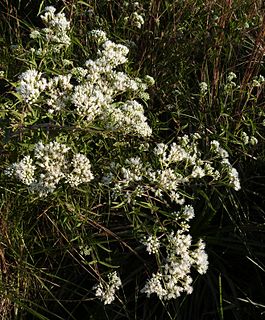| Trichocline | |
|---|---|
 | |
| Trichocline sinuata | |
| Scientific classification | |
| Kingdom: | |
| (unranked): | |
| (unranked): | |
| (unranked): | |
| Order: | |
| Family: | |
| Subfamily: | |
| Tribe: | |
| Genus: | Trichocline Sonder & F.Muell. |
| Type species | |
| Trichocline skirrophorum Sonder & F.Muell. | |
| Synonyms [1] | |
Trichocline is a genus of Australian and South American plants in the gerbera tribe within the daisy family. It consists of one species from Australia (T. spathulata) and twenty-three from South America. [2] [3] [4]
Its closest relatives are Chaptalia , Gerbera , Leibnitzia , Perdicium , and Oreoseris . Together they form the Gerbera complex in the tribe Mutisieae. [3]
- Species [1] [5]
- Trichocline aurea (D.Don) Reiche - Chile
- Trichocline auriculata (Wedd.) Hieron. - Argentina, Bolivia
- Trichocline boecheri Cabrera - Argentina
- Trichocline catharinensis Cabrera - Rio Grande do Sul, Santa Catarina
- Trichocline caulescens Phil. - Chile
- Trichocline cineraria (D.Don) Hook. & Arn. - Chile, Argentina
- Trichocline crispata Cabrera - Chile
- Trichocline dealbata (Hook. & Arn.) Benth. & Hook.f. ex Griseb. - Chile, Argentina
- Trichocline deserticola Zardini - Chile
- Trichocline eriopus Baker - Brazil
- Trichocline exscapa Griseb. - Argentina
- Trichocline heterophylla (Spreng.) Less. - Brazil, Paraguay, Uruguay
- Trichocline hieracioides (Kunth) Ferreyra - Peru, Ecuador
- Trichocline humilis Less. - Argentina, Paraguay, Uruguay
- Trichocline incana (Lam.) Cass. - Chile, Bolivia, Argentina, Uruguay, Rio Grande do Sul
- Trichocline linearifolia Malme - Paraná
- Trichocline macrocephala Less. - Misiones, Paraná, Santa Catarina
- Trichocline macrorhiza Cabrera - Jujuy
- Trichocline maxima Less. - Brazil, Uruguay
- Trichocline plicata Hook. & Arn. - Argentina
- Trichocline reptans (Wedd.) Hieron. - Argentina, Paraguay, Bolivia
- Trichocline sinuata (D.Don) Cabrera - Argentina
- Trichocline spathulata (A.Cunn. ex DC.) J.H.Willis - Western Australia
- Trichocline speciosa Less. - Paraná, Argentina, Paraguay
- formerly included [1]
see Actinoseris Chaptalia Criscia Richterago Unxia
- Trichocline angustifolia - Unxia suffruticosa
- Trichocline arenaria - Richterago arenaria
- Trichocline cordifolia - Chaptalia cordifolia
- Trichocline heterophylla - Criscia stricta
- Trichocline oblonga - Chaptalia oblonga
- Trichocline ovalis - Chaptalia oblonga
- Trichocline radiata - Actinoseris radiata











